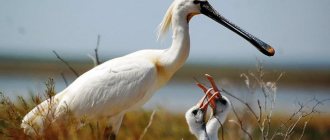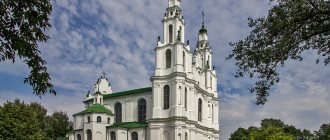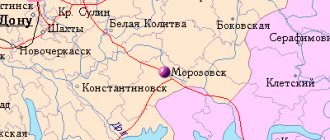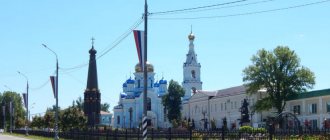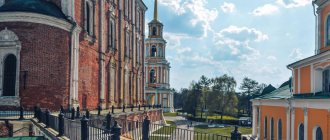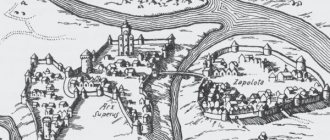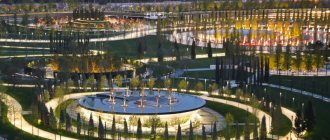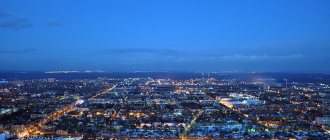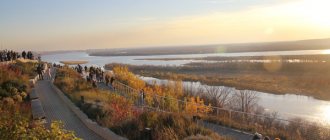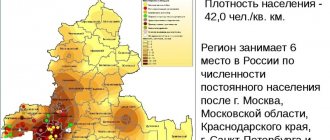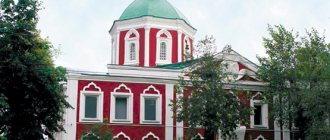Archaeological Museum-Reserve "Tanais"
Archaeological Museum-Reserve "Tanais".
Khutor Nedvigovka, Rostov region. Photo: Arestov Andrey Pavlovich / photobank “Lori” “Tanais” is one of the first archaeological reserves in Russia. It is located in the Nedvigovka village of the Rostov region. Almost five thousand years ago, the border between Europe and Asia passed here and a Greco-Scythian-Sarmatian-Maeotian city stood. Its traces were discovered by Soviet archaeologists in 1955.
The site of Tanais was the northernmost point of ancient civilization. Monuments of different cultures have been preserved here - from the Paleolithic to the 19th century. All exhibitions are outdoors. In the museum you can learn how the Tanait defended themselves from the enemy, cultivated wheat and fished. More than 140 thousand ancient objects tell about this, including a marble altar, ceramic dishes, women's jewelry, ancient fabrics of the 14th century and other artifacts.
Novocherkassk Holy Ascension Cathedral
Novocherkassk Holy Ascension Cathedral. Novocherkassk, Rostov region. Photo: Yakovlev Andrey Alexandrovich / photobank “Lori”
Novocherkassk Holy Ascension Cathedral is a historical monument of the Don Cossacks. It is the third largest in Russia after the Cathedral of Christ the Savior and St. Isaac's Cathedral. The cross on the main dome is decorated with rock crystal crystals with diamond edges. They shine so brightly that the cathedral is even called “the second sun of the Don.”
Inside the temple, the walls are painted with frescoes, and the choirs (balconies) are decorated with paintings on scenes from the history of the local Cossacks: “Ermak’s preparations for the campaign in Siberia”, “Grant of the Tsar’s Banner under Tsar Mikhail Fedorovich in 1614”, “Azov Seat in 1641” and many other. The lower temple-tomb was consecrated in honor of the Intercession of the Most Holy Theotokos. Sarcophagi are installed here in which the founder of Novocherkassk Matvey Platov and the heroes of the Patriotic War of 1812 rest: Vasily Orlov-Denisov, Ivan Efremov, Pyotr Baklanov and others.
State Museum-Reserve M.A. Sholokhov
Memorial House M.A. Sholokhov in the Kruzhilinsky farm. Village Vyoshenskaya, Rostov region. Photo: sholokhov.ru
The Mikhail Sholokhov Museum-Reserve is the only state museum of the writer in Russia. It includes a memorial house in the village of Kruzhilinsky, where Sholokhov was born, a house-museum in the village of Karginskaya, where he wrote “Don Stories,” a house in the village of Veshenskaya, in which the writer worked on “Quiet Don” and “Virgin Soil Upturned,” as well as memorial estate where the Sholokhovs lived from 1949 to 1984.
The museum exhibits tell about the life and work of the writer. Among them are personal belongings of Sholokhov and his family: books, manuscripts, photographs, film and sound recordings, documents, illustrations for books and first editions of works. Also here you can see a unique exhibition “Novel in the Open Air”: its exhibits are the farms and villages described in the novel “Quiet Don”.
LiveInternetLiveInternet
Quote from TatiRoss message
Read in full In your quotation book or community!
48 interesting places in the Rostov region
1. Healing mud of Lake Gruzskoe
Gruzskoye is a salty mud lake in the southeastern part of the Oryol district of the Rostov region. Belongs to the Manych lake group of reservoirs of relict (marine) origin. Lake Gruzskoe is located north of Lake Manych-Gudilo, from which it is separated by a flat hillock up to 3-5 m high. The slopes of the hillock are gentle. The lake has a fairly regular elongated oval shape, about 10.5 km long and 1.5 km wide. The shores of the lake rise up to 3 m in places; several steppe ravines flow into it. On the northern shore of the lake is the village of Manych. The lake produces brine, the mineral water of the lake. The amount of brine depends on the air temperature (season of the year) and the amount of precipitation. In the absence of wind, the brine is evenly distributed over the surface of the lake bottom. When the wind blows, it quickly moves to one side, sometimes exposing 2/3 or more of the lake bottom. The surface of the lake with brine is always smooth and mirror-like. Rapa has a bitter-salty, burning taste; The brine is oily to the touch. The temperature of the brine fluctuates according to the seasons of the year. In summer, it reaches 20–38 degrees thanks to the high and steep banks that protect the lake from the wind. Since the 17th century, the Manych climate clinic has been operating on the shores of Lake Gruzskoe. Treatments with mud, brine baths and kumiss were carried out here. At the beginning of the 19th century, the hospital was closed and resumed operations in 1886. The operation of the hospital was entrusted to the manager of the mining and salt units in the region of the Don Army V.A. Wagner and doctor I.I. Vladykina. In 1908, the sanitary station received the name “Wagner”. On April 10, 1909, the “Regulations on the Wagner Manych-Gruz Sanitary Station” were approved by the highest order. Systematization and analysis of the collected materials allows us to divide the entire period of time from the beginning of the discovery of the medicinal properties of brine and mud from Lake Gruzskoye into four periods by type of use: the first period - episodic use by traditional medicine, the second period - the first experiments of specialists, the third period - organized treatment on a scientific basis, period four - episodic use by medical institutions outside the area of Lake Gruzskoye. The healing properties of Lake Gruzskoye The healing properties of the lake include, first of all, brine and mud. Brine is the name given to the mineral water of the lake, which in terms of table salt content is similar to the mother brine, but differs from it in that its concentration occurs naturally. The color of the brine changes throughout the year: in early spring, when it is heavily agitated by the yellowish snow and rain water flowing into the lake, in July, after settling, it acquires a brownish color, sometimes turning red. The amount of brine depends on the air temperature (season of the year) and the amount of precipitation. According to physical and chemical indicators, they belong to the type of silt mud of seaside reservoirs and are close to the famous Kuyalnitsky mud. The mud is radioactive and highly plastic. In terms of plasticity, the mud of Lake Gruzskoe surpasses all studied medicinal muds. With the help of the mud and water of the lake, you can cure many bone and skin diseases, anemia, nervous system, diseases of the spinal cord and brain, chronic diseases of the digestive system, metabolic disorders, diseases of the musculoskeletal system, and gynecological diseases. Operating reserves are inexhaustible. They amount to 4,226,651 m3 and exceed the combined reserves of mud lakes of the Saki (1,000,000 m3) and Tambukan (1,272,000 m3) deposits and can serve as the base for a specialized mud resort of any capacity. Razdorsky Historical and Ethnographic Museum-Reserve
The Razdorsky Ethnographic Museum-Reserve was organized on the basis of the plan and with the personal participation of the writer Anatoly Veniaminovich Kalinin. In his letter to the Chairman of the Council of Ministers of the RSFSR, M.S. Solomentsev. The writer formulated the task - within the boundaries of the future museum-reserve to concentrate both the most valuable historical and ethnographic array of the middle Don, and the unique beauty of natural places with indigenous lands of the unique right-bank Don viticulture. Don Lukomorye
In the southwest of the Rostov region there are wonderful places: the coast of the Azov Sea, the bend of the Taganrog Bay - a real fabulous Pushkin Lukomorye. This steppe remembers the Scythians and Sarmatians, the Amazons and the warriors of Tamerlane... These shores met the Greeks and Venetians, merchants of the Great Silk Road, the Argonauts and Odysseus, the Turkish khans and Peter. Embankment of the Don River in Rostov-on-Don Embankment of the Don River - in the city of Rostov-on -Don starts from the business and ends near the pier of the Pier restaurant. It runs along the right side of the river, and on the left side of the Don is the so-called Levberdon. The city embankment, named after one of the most famous Russian naval commanders, Fyodor Ushakov, is one of the most famous attractions of the city. {more} Staraya Stanitsa. Loga Park - “Little Switzerland”
Perhaps this is the best free park in Russia. In a small Don farm, its own little Switzerland completely unexpectedly appeared. Over a hundred sculptures, a rabbit hole, crooked mirrors, a rock garden, stunning bridges and gazebos, a water mill, a river, a lake, waterfalls, live deer, swans, peacocks, a sea of greenery, flowers... And all this is outdoors and free for everyone. Pelenkino - healing mud lake
The small lake Pelenkino in the Azov region has unique medicinal mud, the composition of salts being close to Saki, Manych and Tambukan, mined near Pyatigorsk. (Wow) Gray Manych.
The Manych reservoir is located in the Rostov region, 65 km east and southeast of the regional center, within the Kuma-Manych depression on the Manych River, or Western Manych (the river flows in Kalmykia, the Rostov region and the Stavropol Territory). The Manych is a left tributary of the Don and enters the Don basin. How much feather grass? 88. Ethno-archaeological complex “Lost World”
In one of the most famous and celebrated places of the Don, in the Ust-Donetsk district of the Rostov region, where the great river seems to reluctantly turn in the sun in one direction or the other, the Pukhlyakovsky farm is located. These are the famous Kalinin places - those where the writer Anatoly Kalinin lived and worked, familiar to most from the film “Gypsy”, based on his book. 99. Karaul Mountain in the Rostov region (place described by Prophetic Boyan)
“Isn’t it stupid for us to talk, brethren, to begin with old words of difficult stories About Igor’s cry, Igor Svyatslavlich? Start your song according to the epics of this time, and not according to Boyan’s plans. Boyan, the prophetic one, if someone wants to create a song, his thoughts spread across the tree, like a gray fork across the earth, like a crazy eagle under the clouds. Let’s remember the strife of the first times”... 110. Aksai catacombs
Aksai catacombs, a mysterious and mystical place, is located in the suburbs of Rostov, the city of Aksai. The tunnels stretch for many kilometers and their total length is more than a hundred kilometers, and this is only a known part of them. The catacombs are clearly of artificial origin, and the time of their construction has not yet been established, but most likely they are more than one thousand years old, and who created this system of underground passages has also not been established. 111. Skeletal rock (Krasnosulinsky district) This is where my entire childhood was. I don’t even know. It seems to me that almost all of Krasny Sulin is on such skeletal hills. There are a lot of them there.
The Skelevataya rock is located on the outskirts of the city of Krasny Sulin, in the village of Skelevatka. The name of the rock, according to one version, comes from the word “skeleton” - the layers of rocks in the massif are very similar to ribs. And according to another version - from the Ukrainian word “skelya” (“rock”). If you stick to this theory, you get a funny name - "Rocky Rock". The length of the massif is over one kilometer, the height of Skelevataya Rock reaches 25 meters. 112. Underground monastery (Migulinsky caves)
A real miracle - an ancient underground monastery, carved into a chalk hill, is located in the very north of the Rostov region, a few kilometers from the village of Migulinskaya, Verkhnedonsky district. The catacomb monastery complex is located in an 80-meter cliff above the Don and consists of two caves - Old and New. The names “Old” and “New” are arbitrary. Both cave complexes were cut down at the same time. It’s just that our contemporaries found the entrance to the New Cave later. 113. Long canyon in the Rostov region
The belief that the Rostov region is continuous steppes is refuted by unique natural and man-made objects that we can be proud of. The Long Canyon is the largest flooded quarry in the Rostov region. The length of the lake in it is 2 kilometers 200 meters. It is located in the Kamensky district, 30 kilometers from Kamensk-Shakhtinsky, near the village of Chistoozerny. 114. Azov is the most ancient city of the Don region
City of bandits. Azov (former names Azak (XIII-XIV centuries), Tana (XV-XVI centuries) is a city in the Rostov region, the administrative center of the Azov region. Population - 81,995 people (2015). The first fortified settlements were formed on the Azov land more than two thousand years ago. 115. The village of Starocherkasskaya is the lost capital of the Don Cossacks. There is no more interesting place on the Don associated with the history of the Don Cossacks than the village of Starocherkasskaya. The village of Starocherkasskaya is located 27 km east of Rostov-on-Don. One of the oldest Don Cossack villages. From 1644 to 1805 - the capital of the Don Cossacks. Since 1970, on the initiative of M.A. Sholokhov, the Starocherkassk Historical and Architectural Museum-Reserve was formed here. 116. Chekhov Taganrog
Taganrog is the birthplace of the great Russian writer A.P. Chekhov. Anyone who lives in the Rostov region or comes here to stay is simply obliged to visit Chekhov’s places. “After Moscow, I love Taganrog most of all,” wrote Anton Pavlovich Chekhov. 117. Archaeological Museum-Reserve Tanais Tanais was founded in the 3rd century. BC e. Greeks, immigrants from the Bosporan kingdom, on the right bank of the former main branch of the mouth of the Tanais River (now Don) - the Dead Donets, after which the city received its name. 118. Rostov Zoo
Rostov Zoo is one of the largest zoos in Russia (with an area of almost 90 hectares), a zoological park rich in its traditions. Located in Rostov-on-Don. Even he was not spared by the corrupt suckers. 119. Rostselmash
Rostselmash is a Russian company, one of the five largest global manufacturers of agricultural machinery. Consisting of 13 enterprises. Production sites in the countries: Canada, Russia, USA, Ukraine and Kazakhstan. 220. Don Father
Don (ancient Greek Τάναις - Tanais) is a river in the European part of Russia. In terms of its catchment area, equal to 422 thousand km², in Europe it is second only to the Volga, Dnieper and Danube. The length of the river is 1870 km. The source of the Don is located in the northern part of the Central Russian Upland, at an altitude of about 180 m above sea level. 221. State Museum-Reserve of M. A. Sholokhov
The State Museum-Reserve of M. A. Sholokhov was created in 1984 and is the only state museum of the writer in Russia. Located in the Rostov region. The basis of his collection is memorial items that belonged to M. A. Sholokhov and his family. 222. Rostov Academic Drama Theater named after Maxim Gorky - “Tractor”
The date of foundation of the theater is considered to be June 23, 1863, when the first performance of the stationary drama troupe took place. The theater building was built in 1935 and restored after the war in 1963. 223. Rostov State Musical Theater - “White Piano”
Rostov-on-Don is one of the oldest centers of musical life in the south of Russia. In 1919, the Rostov Musical Comedy Theater arose here, and in January 1931 it received state status. 224. State Natural Biosphere Reserve "Rostovsky"
The reserve is located in the southeast of the Rostov region, in the Oryol district, its total area is 9532 hectares. Reserve "Rostov" on the map https://yandex.ru/maps/-/CBUgzJacdA 225. Novocherkassk Ascension Cathedral - Second Sun of the Don . The Patriarchal Ascension All-Cossack Military Cathedral is one of the main attractions not only of Novocherkassk, but also of the entire Rostov region. He is called the “second sun of the Don”. 226. Rostov Arena Stadium
Football stadium on the left bank, built in 2022 specifically to host matches of the 2018 FIFA World Cup. The facade along the entire perimeter is made using media facade technology. 227. Zaitsevskie rocks, Krasnosulinsky district A picturesque corner of the plain between a river, stream, grove and steep cliffs. A place for amateur and professional climbers. The most visited natural climbing wall in the Rostov region. The rocks are made of sandstone. Their height is up to 25 meters. 228. Merzhanovo
A wonderful picturesque place overlooking the bay and with the photogenic scenery of the film “The Lighthouse Keeper”. It is located near Rostov on the way to Taganrog near the village of Merzhanovo. 229. Levoberezhny Park
A park on the left bank of the Don, which was built for the 2018 FIFA World Cup. The park has many benches, exercise equipment, walking areas and paths for cyclists. 330. Park named after the October Revolution in Rostov-on-Don
Located in the city center near Theater Square, it is one of the popular places to relax. It houses many entertainment venues, a skating rink, a Ferris wheel, children's attractions, and a rope park. At night, beautiful illumination turns on. A must visit! 331. Cinema cluster “Don” in the fortress of St. Anna
The film cluster is located in a fortification near the village of Starocherkasskaya, Rostov region. The fortress is a branch of the Starocherkassk Museum-Reserve. This is a monument to the military-defensive architecture of Russia in the 18th century. It was built in 1731. Construction is still underway. Filming locations will be divided into two zones. The first will consist of Russian scenery, architecture of the 18th-20th centuries. In the other they want to locate the embankments of Italy, France, England and Germany. 332. Recreation center "Eldorado" Recreation center "Eldorado" is a picturesque place located in a picturesque canyon on the shore of a blue lake. On the territory there is a children's playground, a bathhouse, several bars, a night club, a shop, a sports equipment rental point, a paid parking lot, and gazebos with barbecue areas. "Eldorado" is located 140 km from Rostov-on-Don and 10 km from Kamensk-Shakhtinsky. 333. House of Faina Ranevskaya
Address: st. Frunze, 10, Taganrog. Soon, a museum of this famous actress will appear in this house (the deadline for completion is 2019). Local residents also consider the “Freken Bock” coffee shop, which opened nearby in 2009, to be a truly real monument to the actress. 334. Taganrog stairs and Taganrog embankment
The staircase is one of the attractions of Taganrog, length - 108 m, width - 6.5 m. It leads to the picturesque Pushkinskaya embankment. Laquiera Castle
A unique estate complex. Popularly, the main house of this complex was called “Lakiera Castle”, as it was built in the style of a medieval castle (pseudo-Gothic style). Address: Miusskaya st., 4, Zolotaya Kosa village House-Museum of P.I. Tchaikovsky
About the building, which is now called the Tchaikovsky House, the great Russian writer Anton Pavlovich Chekhov wrote to his brother: “If I were rich, I would certainly buy the house where Ippolit Tchaikovsky lived.” Indeed, this house is very beautiful. Built on a high, steep green cliff, made of bright red brick, with a crenellated tower, a high spire and medieval-style windows, the mansion gives the impression of a real castle. In addition to the fact that this house itself is of enormous cultural and architectural value, the great composer Pyotr Ilyich Tchaikovsky also visited here when he visited his brother. Today there is a museum dedicated to the composer and a chamber concert hall. Address: Grecheskaya st., 56, Taganrog Memorial of Glory on the Sambek Heights A memorial complex erected in the Neklinovsky district of the Rostov region near the village of Sambek in honor of the soldiers of the 130th and 416th rifle divisions, awarded the honorary name “Taganrog”. Tachanka (monument)
Tachanka-Rostovchanka - a monument (monument) built in the year of the 60th anniversary of the Great October Socialist Revolution. Dedicated to the First Cavalry Army during the Civil War. Fisherman's district Bogudonia
Bogudonia (or where this area is now located) has long been inhabited by fishermen. The brave “sea wolves” built houses as and where they had to, so today the area is an interweaving of narrow streets with small houses huddled together. In addition to the fact that there were always shops with freshly caught fish, there were also workshops that repaired fishing boats and boats. Here, nets were knitted for fishermen, there were smokehouses, glaciers and other shops and establishments related to fishing. Botanical Garden of Southern Federal University
A rich collection of tropical and subtropical flora of Australia, Southeast Asia and the Americas is presented in the greenhouse. The “Azov Steppe” exposition is a small corner of a virgin landscape, surrounded by pine and oak groves, with a special area allocated for medicinal and essential oil plants. The Botanical Garden Museum houses a large herbarium and a collection of seeds. Numerous paths and a special “Ecological Trail” are laid across the territory, designed for a two-hour walk. There are benches in the clearings. Along the way you can see a 300-year-old “dinosaur tree” of ginkgo, pedunculate oaks, juniper, and boxwood. Guides tell tourists interesting stories about the world of plants. In the Botanical Garden there is a store where they sell seeds and seedlings of zoned varieties of flowers and fruit trees. The educational center organizes children's clubs and a summer camp. Here, future botanists participate in the work of a biological laboratory, learn to collect samples, isolate and analyze DNA. On the territory of the garden there is a mineral spring named after St. Seraphim of Sarov. Its water is considered healing. Paramonovsky warehouses
A complex of warehouse buildings of the 19th century in Rostov-on-Don. Located on the banks of the Don, between Sokolov Avenue and Universitetsky Lane. Monument of federal significance.
Memorial to the rush of Soviet tankers to German airfields in the Rostov region in November 1942. The monument stands at the exit from the Don highway to the Tatsinskaya village, 220 km from Rostov. In December 1942, the offensive operation “Little Saturn” took place on the middle Don. Soviet troops, having broken through the fascist defenses, rushed to the rear of the fascist German troops, sweeping away all obstacles along the way. One of the targets of this operation was the German airfield in the village of Tatsinsky. Tankers of the tank corps under the command of General Badanov, passing deep behind enemy lines through the snow, in severe frost, on December 24, 1942, destroyed over 300 enemy aircraft at this airfield and Tatsinskaya railway station, destroying the “air bridge” created by Hitler’s Germany to provide assistance surrounded at Stalingrad by the 330 thousandth army of General Paulus. Desert Big Buruny
Among the endless expanses of fields and open steppe of the Verkhnedonsky region, the Bolshie Buruny desert strikes the imagination. This creation of nature stretches for several kilometers in the bend of the Peskovatka River near the villages of Solontsovsky and Morozovsky. It is hidden from the scorching southern sun by a deciduous forest. This, of course, is not the Sahara, but a micro-desert, but it is so unusual and amazing that it is worth admiring the place. The endless sands are mesmerizing. Experts say that these are glacial sands; they were brought here about half a million years ago by the waters of melting glaciers. This place looks amazing, in the valley of the Peskovatka River, in the middle of pine forests, as if some ancient titan poured out a giant Kamaz of sand and created a sandbox. Place on the map https://yandex.ru/maps/-/CBuDJ-G8oB Mountain “Two Sisters”, Rostov region In the Rostov region there is an unusual and beautiful natural monument - the Mountains Two Sisters, similar to each other like two drops of water. Hundred-meter mountains stand on the banks of the Seversky Donets River, not far from the town of Belaya Kalitva. The mountains were formed as a result of the shifting of the earth's crust and are layers of volcanic rocks. The mountains are similar not only with identical slopes at an angle of almost 45°, but also with two limestone layers about 10 meters thick running from top to bottom, unique natural stone ridges. On the southern side of the mountain there is a floodplain forest and a spring of clean water. Near the mountains there are large deposits of Donetsk coal. According to numerous legends, countless treasures are buried at the foot of the mountains. Place on the map https://yandex.ru/maps/-/CBUkeQXn3C Shchepkinsky forest
The largest natural planting in Rostov is in the northern part of the city, and our summer cottages are nearby. Named after the Shchepkinskaya ravine, located on the site of the current forest. In addition, according to some sources, the reserve was named after the nearby settlement of. Shchepkin. Length of the park: from north to south - 4 km, from west to east - 4-4.5 km. At the beginning of the 20th century, in the Rostov region, near the village of Shchepkino, it was decided to begin planting tree crops. This became the background to the creation of the Shchepkinsky Party Reserve. It is known that the reserve was planted for breeding various species of animals on its territory, but the idea failed and economic activity was curtailed. There are forested areas left that impress with their picturesqueness. The extensive forestry contains a wide variety of vegetation types. Today the Shchepkinsky forest is the largest man-made forest plantation near the city limits of Rostov. Residents of Rostov love to spend holidays on the territory of the reserve because of the picturesqueness of these places. In addition to holding holidays, townspeople organize various games here, and paintball competitions are held. Shchepkinsky forest on the map https://yandex.ru/maps/-/CBuHFJfzxB
Beglitsky Spit
The Beglitsky Spit is an alluvial sand and shell spit, located on the northern Russian coast of the Sea of Azov, in the Taganrog Bay, approximately 25 km west of the city of Taganrog. There are several small freshwater lakes on the spit, which usually dry up during the hot summer months. Also on the spit are abandoned buildings of the Orlov fish collective farm (several brick barracks, and a pier destroyed by the surf) and, at the extreme eastern end of the spit, a lighthouse. The bay between the spit and the shore, which has an almost circular shape, is shallow and freshwater, mostly overgrown with algae. Due to the lack of any infrastructure on the spit, camping with tents is common. Few tourists are attracted by the large sand and shell beach (the share of quartz sand and shell rock reaches 70%) and mud procedures, since the bottom of the shallow bay of the same name is covered with a thick layer of silt (the so-called mulyaka) due to the release of sand and clay deposits in this place. The spit becomes suitable for full swimming only at high tide. The depth reaches 1 m only at a distance of 100 m from the shore. The shallow (in some places up to 50 cm) depth of the sea attracts families with small children, and thanks to the constant winds and the absence of high vegetation, the Beglitsky Spit is popular with hang gliders and paragliders. Beglitskaya Spit on the map https://yandex.ru/maps/-/CBuXm8wKpB "Ginkgo Park" in Novocherkassk
The history of the Park began in 2001, when landscape designer Alexander Tolokonnikov built the first private botanical park in Russia. In the steppe climate zone, on the site of an abandoned clay quarry in the city of Novocherkassk, Alexander created a unique garden - Ginkgo Park. Today, the Park is visited annually by several thousand people. During the warm season, psychological trainings and concerts, yoga and dance classes, film screenings and thematic meetings with interesting people, as well as classes at the School of Landscape Design are held here. The territory of the Park is divided into several zones and includes a classic English garden, an apothecary garden and a Japanese garden. The tea pavilion, located under a ginkgo tree on a pond in the Japanese garden, is its highlight. Species of this unique tree grew throughout the world tens of millions of years ago. Scientists have been able to identify at least ten different species, but all but the biloba have become extinct. In the Far East, ginkgo biloba is a symbol of love, happiness and wisdom. Monks plant it in holy places, near monasteries, considering the fan-shaped leaves to be similar to the two phases in Taoist philosophy - yin and yang. Address: Novocherkassk, st. Begovaya, 8. “Ginkgo Park” on the map https://yandex.ru/maps/-/CBuhrDWw1D Kazanskaya village - “Northern capital” of the Rostov region
Stanitsa Kazanskaya is the “capital” of the Verkhnedonsky district of the Rostov region. There is a border here, albeit not with another country, but with a region. Around are lakes and small rivers flowing into the Don. High school students are walking along the streets. And even the smallest resident will show you the house where Pushkin once stayed - because now there is a kindergarten in this building. And in 2009, a drawbridge was built here - now Kazanskaya can accurately be called the “northern capital”.{/more}
Surb-Khach Church in Rostov-on-Don
Church of Surb-Khach. Rostov-on-Don. Photo: Viktor Filippovich Pogontsev / photobank “Lori”
The Surb-Khach Church is one of the most ancient in Rostov-on-Don. It was built according to the design of the architect Ivan Starov at the end of the 18th century. The walls of the temple in the classicist style were decorated with khachkars - ancient stone steles with images of crosses. In 1862, the church was rebuilt, and a two-tier bell tower with a high tent was erected nearby. At the monastery there was a seminary and the first printing house in the south of Russia. Over time, the temple began to collapse, but in 1968–1972 it was restored. The Museum of Russian-Armenian Friendship was opened here.
Today Surb-Khach is an Armenian Apostolic Church. The temple and the surrounding park are located on the right bank of the Northern Reservoir, and a spring flows from under the hill on which it stands. Armenian poets and public figures are buried near the walls of Surb Khach: Harutyun Alamdaryan, Mikael Nalbandyan, Rafael Patkanyan.
Where to go in the Rostov region by car on your own
First, you should decide on a direction - geographical or interesting to you. A convenient starting point can be the capital of the region, the city of Rostov-on-Don.
Rostov-on-Don
Of course, you should start your acquaintance with the main city of the Don region, the bright, noisy, colorful and hospitable Rostov-on-Don. It is deservedly called the Southern capital and cultural center of the south of the country. This is a city of parks, walking boulevards, museums, theaters, and historical routes. Rostov-on-Don has an incredible concentration of ancient pre-revolutionary mansions and palaces. Most of them are in excellent condition; the most beautiful examples are waiting for you on Bolshaya Sadovaya and Pushkinsky Boulevard.
Rostov-on-Don is also a student youth capital. Here they know how to not only work, but also relax - the Left Bank of the Don is known far beyond the borders of Russia . This is a multi-kilometer area of entertainment and relaxation: restaurants, bars, beaches, recreation centers, pool parties - you definitely won’t get bored. Don't miss the Rostov Zoo , one of the largest in Europe, and be sure to admire the Don from aboard a pleasure boat. It's unforgettable!
Read more: Rostov-on-Don
Center of Rostov-on-Don Photo: © Julia Alisova
Stanitsa Starocherkasskaya
You can also go on a cruise from the Rostov embankment. They offer a variety of options, the most interesting and affordable is the village of Starocherkasskaya. However, if you didn’t get a ticket for the ship, it doesn’t matter; you can get to Starocherkasskaya in 30 minutes along an excellent route.
Starocherkasskaya is officially called a museum-reserve . It includes not only ancient churches, museums, mansions, monuments, but also the very spirit of the Don Cossacks. It is in wicker smokehouses, courtyards, the aroma of Don fish soup, songs, dances, traditional festivals.
And the walk itself along these ancient cobbled streets is very pleasant. Don't forget to visit the Resurrection Military Cathedral, the first stone church on the Don, the heart of the village and the Don Cossacks. In front of him, on Maidan Square, are displayed the trophies of the Azov siege - an unprecedented feat of the Cossacks in the fight against the Turkish army.
More details: Stanitsa Starocherkasskaya
Stanitsa Starocherkasskaya Photo: © Julia Alisova
Azov
You can learn more about the history of the Azov siege in Azov itself, one of the oldest cities in Russia. The almost thousand-year-old handsome man is still cheerful, handsome and young at heart. Azov is a resort city, you can feel it from the signs to the sights, the street names, and the sea scent in the air.
But don’t think that people come to Azov only to have fun, this city is a real treasure trove of attractions. It should definitely be included in your itinerary for traveling around the Rostov region by car. First of all, the Azov Historical, Archaeological and Paleontological Museum-Reserve . The museum is incredibly rich: here you can trace the history of the Don region from ancient times to the present day.
The museum has truly priceless, unique exhibits, the only ones in the world. If you are in Azov, be sure to visit. Also, don’t miss the ramparts of the Azov Citadel, the Powder Magazine of the era of Peter the Great, and the merchant mansions of pre-revolutionary Azov.
Read more: Azov
Azov ramparts Photo: © Julia Alisova
Taganrog
What associations do you have when you hear the phrase “Rostov region”? Don River, crayfish, Cossacks, sunflowers, Sholokhov places? And probably the name of the writer Anton Pavlovich Chekhov - a brilliant playwright, a native of these places. Many fans of the writer come to this resort city to walk through Chekhov’s places - go to “Chekhov’s House” , visit his father’s shop , the theater named after. Chekhov , where his productions are still popular to this day.
But Taganrog is interesting not only for Chekhov; its Old Town is a perfectly preserved example of pre-revolutionary architecture. There are beautiful mansions, museums, real palaces and holy monasteries. The old city of Taganrog has tens of thousands of architectural monuments. Come for at least a weekend!
Read more: Taganrog
“Chekhov’s House” in Taganrog Photo: © olgazav59
Monument to Matvey Platov in Novocherkassk
Monument to Ataman Matvey Platov. Novocherkassk, Rostov region. Photo: Boris Panasyuk / photobank “Lori”
The monument to the Don Ataman, hero of the Patriotic War of 1812 and founder of Novocherkassk Matvey Platov is the first sculptural monument of the city. It was installed in 1853 - on the centenary of Platov’s birth. During Soviet times, the monument was destroyed and restored in the 1990s.
The figure of Platov stands on a high pedestal. He was depicted in a general's uniform and a burka - a sleeveless felt cloak. In his left hand the chieftain holds a mace, and in his right hand a saber. The memorial plaque reads: “To Ataman Count Platov for military exploits from 1770 to 1816. Grateful people of the Don."
Monument to Ermak in Novocherkassk
Monument to Ataman Ermak. Novocherkassk, Rostov region. Photo: Oleg Pchelov / photobank “Lori”
The monument to the Cossack ataman, the conqueror of Siberia Ermak, is one of the symbols of Novocherkassk. It is located on Cathedral Square in the city center. The sculpture was erected in the capital of the Don Cossacks in 1904, almost 35 years after the celebration of the 300th anniversary of the Don Army.
The four-meter figure of Ermak is installed on a high granite block, and the total height of the monument is 12 meters. In the ataman’s left hand is a marching banner, and in his right hand he holds the crown of the ruler of Siberia he conquered. Several inscriptions are carved on the pedestal, including the words of the writer and historian Nikolai Karamzin: “Russia, history and the church proclaim eternal memory to Ermak.”
Where to stay in the Rostov region
So, the travel route has been thought out, all the sights have been explored, restaurants and cafes have been booked. It remains to solve the issue of housing - and in the tourist hospitable Rostov region there will be no problems with this. Moreover, there is an option for every taste and budget - from a bed in a hostel to luxury apartments in a prestigious world chain hotel.
Don't you need to save money? So, choose a beautiful hotel in the center of the Don capital - it’s comfortable, convenient, and fun. Making radial trips around the outskirts of Rostov-on-Don is not difficult. If you want to explore Rostov towns properly, you can choose hotels and guest houses on site. Also, during the warm season, the Rostov region can offer recreation centers with water activities. Inexpensive ones are located on the shore of the Taganrog Bay, more elite ones, with swimming pools and parties, on the Left Bank of the Don.
In the center of Rostov-on-Don, many modern hostels await you if you come alone, with a backpack on your back. They have a special bonus - a great atmosphere of like-minded people. Such hostels often organize joint excursions, outings into nature, and active entertainment for their guests.
- Hotels in Rostov region
- Guest houses
- Apartments, apartments
- Hostels
Don't forget about another way to save money while traveling. This is booking accommodation on Booking.com with cashback.
Read more: Cashback promotion for Tourist. RU
Hotel “Don-Plaza” Photo: © Julia Alisova
Literary Museum A.P. Chekhov
Literary Museum A.P. Chekhov. The building of the former men's classical gymnasium. Taganrog, Rostov region. Photo: Mikhail Markovsky / photobank “Lori”
The Anton Chekhov Literary Museum is located in Taganrog, in the building of a former men's gymnasium - the oldest educational institution in the South of Russia. The writer studied here for 11 years. Until 1975, a secondary school operated in the building, which bore his name.
The exhibition “The Writer and the Motherland” tells about Chekhov’s life in Taganrog. For the 150th anniversary of the writer’s birth, which was celebrated in 2010, a new exhibition was opened here. In it you can see books that were given to Chekhov by famous artists, performers and musicians, as well as photographs and his personal belongings: a hat, jacket, gloves.
Loga Park
Despite the fact that the park is included in the list of the best parks in Russia, not everyone knows about it. An amazing place is located not far from Kamensk-Shakhtinsky. This is 22 hectares of amazing experiences: visitors to the park are literally transported into the world of fairy tales and Russian epics. Here you can meet Koshchei and Baba Yaga, visit the Kingdom of Crooked Mirrors, and admire exotic animals and birds. This kind of entertainment will be interesting for both children and their parents.
Taganrog Museum of History and Local Lore
Taganrog Museum of History and Local Lore. Taganrog, Rostov region. Photo: Alina Sbitneva / photobank “Lori”
The Taganrog Museum of History and Local Lore was opened on the initiative of Chekhov in 1898. It is located in an ancient building, which was built in the mid-19th century by St. Petersburg architect Andrei Stackenschneider in 1848. The palace belonged to Taganrog homeowner Nikolai Alferaki.
The museum exhibits are located in 15 halls. They talk about the history, culture and archeology of the Don region. Artifacts of the Stone Age culture, which were discovered on the territory of the North-Eastern Azov region, are stored here, as well as items made of bone, bronze and stone found during excavations of the Nizhne-Gnilovsky settlement, one of the six ancient city-states on the coast of Asia Minor.
Vodny Island
The unique wild steppe on the Don island Vodny on the island of Manych-Gudilo is a real reserve of wild mustangs. This is a protected area where a herd of wild horses lives. Getting here is not easy: excursions are conducted under the supervision of specialists of no more than ten people during the warm season. On Vodny you can watch wild horses, enjoy natural beauty and feel like you are in a real prairie.
Such a variety of interesting places once again proves the vastness of Russian history and culture. Sometimes you can get an unforgettable experience, touch the untouched beauty of nature and ancient monuments, without leaving your own region.
House-Museum of I.D. Vasilenko
House-museum of the writer I.D. Vasilenko. Taganrog, Rostov region. Photo: tgliamz.ru
The house-museum of the Soviet writer Ivan Vasilenko is located in Taganrog. He lived here with his family from 1923 to 1966, until his death. In this house, Vasilenko wrote several stories for children: “Star”, “The Life and Adventures of Zamorysh”, “Artemka in the Circus”, “The Magic Box”. In 2004, an exhibition was opened here where you can see the writer’s personal belongings, documents, drafts, journals and photographs. Four years later, an exhibition dedicated to the “Cycle of Works about Artemka,” one of Vasilenko’s main children’s characters, appeared in the house. The museum also houses an exhibition of paintings by artist Mikhail Sychev, a friend of Ivan Vasilenko.
Author: Irina Malakhova
